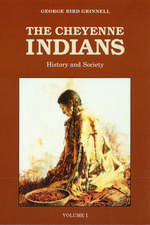Washakie, Chief of the Shoshones
Autor Grace Raymond Hebard, Richard O Clemmer–smithen Limba Engleză Paperback – 30 sep 1995
Washakie was chief of the eastern band of the Shoshone Indians for almost sixty years, until his death in 1900. A strong leader of his own people, he saw the wisdom of befriending the whites. Grace Raymond Hebard offers an engaging view of Washakie’s long life and the early history of Shoshone-occupied land—embracing present-day Wyoming and parts of Montana, Idaho, and Utah. Washakie is seen signing historic treaties, aiding overland emigrants in the 1850s, and finally assisting whites in fighting the Sioux. According to Hebard, Washakie’s role in the battle on the Rosebud in June 1876 saved General Crook from the fate that befell General Custer eight days later on the Little Big Horn.
Preț: 110.69 lei
Nou
Puncte Express: 166
Preț estimativ în valută:
21.19€ • 23.10$ • 17.82£
21.19€ • 23.10$ • 17.82£
Carte disponibilă
Livrare economică 27 noiembrie-11 decembrie
Preluare comenzi: 021 569.72.76
Specificații
ISBN-13: 9780803272781
ISBN-10: 0803272782
Pagini: 326
Ilustrații: Illus., maps
Dimensiuni: 152 x 229 x 15 mm
Greutate: 0.49 kg
Editura: MQ – University of Nebraska Press
Locul publicării:United States
ISBN-10: 0803272782
Pagini: 326
Ilustrații: Illus., maps
Dimensiuni: 152 x 229 x 15 mm
Greutate: 0.49 kg
Editura: MQ – University of Nebraska Press
Locul publicării:United States
Notă biografică
Grace Raymond Hebard (1861–1936) wrote the two-volume Bozeman Trail (Nebraska 1990).
The introducer, Richard O. Clemmer-Smith, is a professor of anthropology at the University of Denver and the author of Roads in the Sky: Economic Change and Cultural Continuity among the Hopi.
Recenzii
“A book of great merit. . . . Persons interested in the history and romance of the West will be grateful.”—LeRoy R. Hafen, Journal of American History
“Hebard has assembled a great deal of interesting and valuable material from the correspondence and memoirs of the fur traders, missionaries, army officers, and pioneers, who were instrumental in opening the region to white settlement.”—American Historical Review
“[This] tribute to an Indian chief who stands preeminent as a factor in the development and settlement of the Northwest, and as friend of the United States through the period of the building of the Union Pacific Railroad, is a distinct and important contribution to the history of the Northwest from 1840 to 1900.”—Boston Transcript













